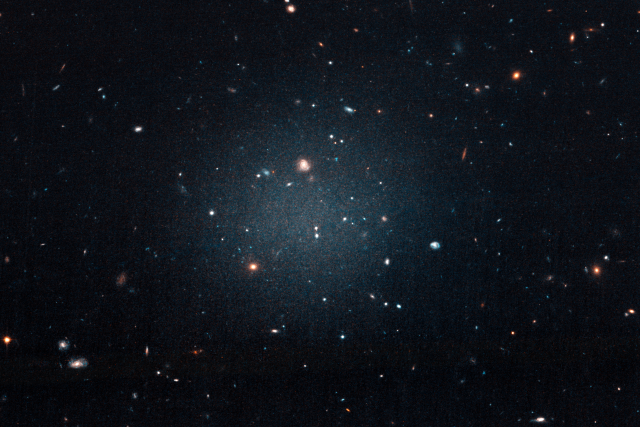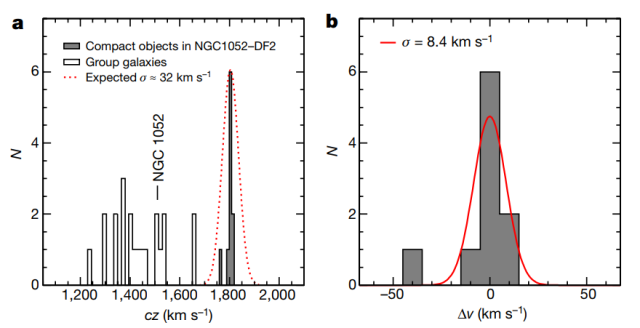Galaxies with no dark matter?
Astrophysicists from Yale University have recently claimed the discovery of a galaxy lacking dark matter 1. But, to fully understand (and assess) the excitement produced by this paper, let’s review a couple of things regarding dark matter and galaxies. In the current lambda-Cold Dark Matter (ΛCDM) paradigm, the most accepted “theory to model the Universe in large scales”, baryonic (visible) matter assembles where dark matter is denser. For this reason, it is expected that all visible galaxies reside embedded within a dark matter halo. However, it has been known for some time now that this is not the case for all galaxies. The origin of some of them is related to merger events, being the outcome of the collapse of gas and dust that have been flung out of merging systems. As a consequence, the galaxies formed in this manner should end up having no dark matter at all. These galaxies are named “tidal dwarfs” 2, and not only have they been found observationally, but are also the solution to explain, for instance, why some galaxies such as the Milky Way, M31 or CentaurusA have satellites (dwarf galaxies) orbiting in a plane around them (3, aspect that has been previously used against ΛCDM). Having said this, a galaxy lacking dark matter does not seem so strange, does it?

NGC1052-DF2 is a faint, extended galactic system located in projection in the NGC1052 group of galaxies. Such faint object is only observable using space photometry (Hubble Space Telescope, see figure 1) or wide field observations optimized to detect low surface brightness structures. Other observations only reveal an over-density of point-like sources where the galaxy is located, over-density that has been associated with the globular cluster system of NGC1052-DF2. An analysis of the photometric properties of the galaxy, together with a careful study of how those globular clusters move around it, have allowed van Dokkum’s team to conclude that this galaxy has a very low amount of dark matter around it, being compatible with an absolute absence.
These findings are compatible with NGC1052-DF2 being i) a tidal dwarf, ii) consequence of a complex interaction between matter and quasar winds, or iii) the remnants of disruption of material falling towards NGC1052. In addition, contrary to what might be expected, the discovery of galaxies with no dark matter strongly supports the well-established ΛCDM paradigm: Alternative theories as MOND (Modified Newton Dynamics) will fail at reproducing the properties of a galaxy with no dark matter. The explanation is simple. In ΛCDM you can avoid the effect of dark matter by simply not adding it, whereas in MOND, where the physics has been modified to consider the effect of such elusive matter, you will always have its effect. Until this point everything seems fair and interesting. However, strong claims require even stronger evidences, and here is where this work is causing great controversy in the astrophysical community.

The idea behind this study is “simple”. On the one hand, by knowing the light that is emitted by the system, we can obtain the baryonic mass, the amount of normal/visible matter that composes the galaxy and that is emitting such light. This way, the authors state that NGC1052-DF2 has around 2×108 solar masses. On the other hand, by inspecting how the system of globular clusters orbits around it (see figure 2), we can infer the total amount of mass, i.e. the mass that affects the movements of such globular clusters, including baryonic and dark matter. By doing this, the authors find that this galaxy should have a dark matter halo less massive than 1.5×108 solar masses, compatible with having few (or even an absence) of dark matter.
However, there are subtle but important aspects of the author’s analysis that deserve some clarification and that are making astrophysicists all around the world to revisit their results. First, the derivation of the amount of baryonic matter in this system relies on its distance. In Astronomy, everything is projected into the celestial sphere. Depending on the distance to the objects, they might be extremely small and located in our vicinity or extremely large and located far away from us, having in both options the same angular size. A plane and a bird do look similar in the sky, don’t they? The authors assume a distance to NGC1052-DF2 of 20 Mpc, whereas other distance estimators (also shown by the authors) suggest that the system is only 10 Mpc away from us. Such factor of two would move NGC1052-DF2 from a galaxy lacking dark matter to a normal dwarf galaxy. In addition, assuming a distance of 20 Mpc would imply that all the globular clusters surrounding it would be similar to ω Centauri, the largest globular cluster in our Milky Way, something that is quite unlikely. Secondly, a different source of caution comes from the derivation of the dark matter (dynamical matter). For doing that, the authors are using the kinematics of just 10 systems located all around the target. The data analysis of such small sample is full of uncertainties, uncertainties that once more, would move our target from a galaxy lacking dark matter to a normal dwarf system (although we must admit that in this sense the authors did quite a thorough job).
This articles is not intended as criticism towards this interesting discovery, but rather as a reflexion on how science works. Science is a collaborative effort in which every member contributes their bit. Trial and error and working as a community (paying attention to what other scientists think about our work) are what have made it possible to know what we know about the Universe around us. Astronomy is no exception.
References
- van Dokkum, P.; Danieli, S.; Cohen, Y.; Merritt, A.; Romanowsky, A. J.; Abraham, R.; Brodie, J.; Conroy, C.; Lokhorst, D.; Mowla, L.; O’Sullivan, E.; Zhang, J. “A galaxy lacking dark matter”, Nature, Volume 555, issue 7698, pp. 629-632 (2018). DOI: 10.1038/nature25767. ↩
- Lelli, F.; Duc, P.A.; Brinks, E.; Bournaud, F.; McGaugh, S. S.; Lisenfeld, U.; Weilbacher, P.M.; Boquien, M.; Revaz, Y.; Braine, J.; Koribalski, B.S.; Belles, P.E. “Gas dynamics in tidal dwarf galaxies: Disc formation at z = 0”, A&A, Volume 584, A113, 25 pp (2015). DOI: 10.1051/0004-6361/201526613. ↩
- Ibata, R. A.; Lewis, G. F.; Conn, A. R.; Irwin, M. J.; McConnachie, A. W.; Chapman, S. C.; Collins, M. L.; Fardal, M.; Ferguson, A. M. N.; Ibata, N. G.; Mackey, A. D.; Martin, Nicolas F.; Navarro, J.; Rich, R. M.; Valls-Gabaud, D.; Widrow, L. M. “A vast, thin plane of corotating dwarf galaxies orbiting the Andromeda galaxy” Nature 493, Issue 7430, pp. 62-65. (2013) DOI: 10.1038/nature11717. ↩
5 comments
Dark matter fills ’empty’ space, strongly interacts with visible matter and is displaced by visible matter.
The reason for the mistaken notion the galaxy is missing dark matter is that the galaxy is so diffuse that it doesn’t displace the dark matter outward and away from it to the degree that the dark matter is able to push back and cause the stars far away from the galactic center to speed up.
It’s not that there is no dark matter connected to and neighboring the visible matter. It’s that the galaxy has not coalesced enough to displace the dark matter to such an extent that it forms a ‘halo’ around the galaxy.
A galaxy’s halo is not a clump of dark matter traveling with the galaxy. A galaxy’s halo is the state of displacement of the dark matter.
It is not that dark matter fills empty space, dark matter defines the great scale structure of the Universe in the form of filaments (http://astronomy.swin.edu.au/cosmos/L/Large-scale+Structure). This dark matter interacts with visible or baryonic matter only via gravity. As a consequence, visible matter also follows this structure and is clustered where dark matter is denser (forming galaxies). Thus, the visible part of galaxies (with the exception of tidal dwarfs) is surrounded and embedded within dark matter haloes. In the same sense, large amounts of dark matter is found filling the space between galaxies in galactic clusters. Both, dark and visible matter, coexist in the Universe and thus, visible matter does not displace dark matter.
Recently, the existence and survival of faint and extended galaxies in clusters of galaxies (ultra diffuse galaxies) was (and still is) interpreted as a proof favouring that these systems should be embedded within large dark matter haloes stabilizing them. This fact, in principle, makes these systems some of the more dark-matter dominated objects in the Universe (with some researchers claiming that they should be embedded even in a Milky-Way-like dark matter halo). Nowadays, we think that they are embedded in dwarf-like haloes (not so massive). It will be the time and further investigations what will allow us to conclude whether this particular galaxy is really lacking dark matter or not.
Dark matter fills ’empty’ space, strongly interacts with visible matter and is displaced by visible matter.
The reason for the mistaken notion the galaxy is missing dark matter is that the galaxy is so diffuse that it doesn’t displace the dark matter outward and away from it to the degree that the dark matter is able to push back and cause the stars far away from the galactic center to speed up.
It’s not that there is no dark matter connected to and neighboring the visible matter. It’s that the galaxy has not coalesced enough to displace the dark matter to such an extent that it forms a ‘halo’ around the galaxy.
A galaxy’s halo is not a clump of dark matter traveling with the galaxy. A galaxy’s halo is the state of displacement of the dark matter.
The more compact the cluster the greater the displacement of the supersolid dark matter connected to and neighboring the cluster, the greater the displaced dark matter pushes back and exerts pressure toward the cluster, the faster the stars move in the cluster.
[…] Galaxien egituraren analisiak ondorioztatu zuen materia iluna izeneko zerbait existitu behar zela berau azaltzeko. Zenbait kontu berplanteatzea ekarriko du aurkikuntza berri batek? Tomás Ruiz-Larak erantzuten dio honi: Galaxies with no dark matter? […]
[…] El análisis de la estructura de las galaxias llevó a la conclusión de que debía existir algo llamado materia oscura para explicarla. ¿Hará un nuevo descubrimiento replantearse algunas cosas? Tomás Ruiz-Lara responde a esta cuestión en Galaxies with no […]